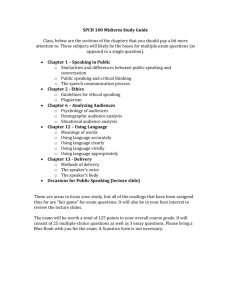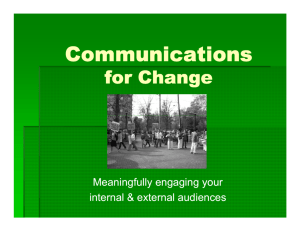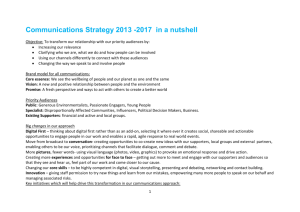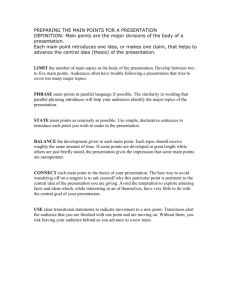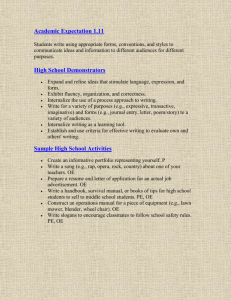Chap - 7 - Professor Leach
advertisement
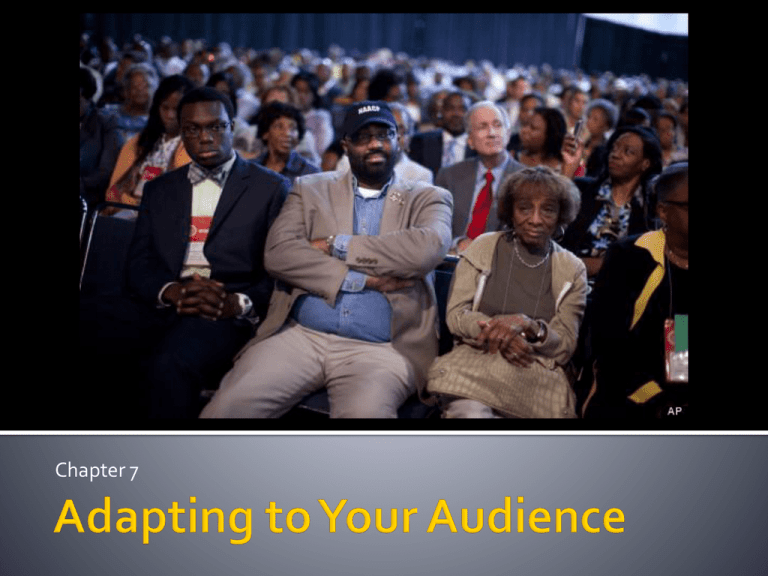
Chapter 7 Audience adaptation Adapting to audience demographics Knowing your audiences demographics affect choices during speech development Topic selection Will be determined by audiences interests and needs Demographics can help understand these Examples Demographics will also help use examples that your audience can relate to How many of you have ever heard of “Super Chicken” Language Culture, Sexual orientation, & diversity of audience will all play a part in the language you use during your presentation Avoid Stereotyping ▪ An oversimplified picture of people different from us ▪ If you have a diverse audience be careful not to let these fall in to your speech ▪ What are some common stereotypes people have of different demographic groups Adapting to the speaking environment Our classroom will remain the same, but with outside opportunities Plan Ahead Where will you position yourself, how will audience be seated, Will you need a microphone, whiteboard, equipment, etc Look the part You should be as neat and professional as your audience It is better to be a more formal than audience than less formal Adapting to the speaking environment Our classroom will remain the same, but with outside opportunities Arrive early This will help you determine what adjustments, if any, are needed for your presentation before the audience arrives Choose speaking style Size of audience often dictates speaking style Small groups more conversational (Sometimes seated with them) Large groups more formal, vocal variety, amplification Meeting audience expectations Make sure you address the content to be covered so audience will know what to expect during speech Where would you identify what will be covered? Take questions at the end of presentation incase there are unmet expectations you can clear up Anticipating audience will help to customize your speech for that specific audience Benefits of audience analysis and adaptation Maintain high levels of interest By including content appropriate for that audience Achieve speech goal & Meet expectations By understanding what the audience wants and needs and focusing on that during development Benefits of audience analysis and adaptation Handle adversarial audiences Knowing you will have opposition (controversial topics) will help prepare for negative or angry audience members Avoid embarrassing subjects or remarks Knowing the make up of your audience will help prevent you from saying offensive or insulting comments during your presentation Read non verbal cues ▪ Eye contact ▪ Indicates engagement & listening ▪ Facial expressions ▪ Varies based on expressive nature of culture ▪ Movement ▪ Indicates lack of interest Squirming, shuffling, etc. Read non verbal cues ▪ Nonverbal responsiveness ▪ Applauses, nods, etc. ▪ Indicates interest & support ▪ Lack of indicates disinterest ▪ Verbal responsiveness ▪ Shout outs ▪ Whispers to neighbors around them Respond to nonverbal cues ▪ Inattentive or bored audiences ▪ ▪ ▪ ▪ ▪ Tell a story Use relatable example Reinforce importance of message Eliminate abstract facts/stats Use humor (make sure it’s appropriate) Respond to nonverbal cues ▪ Inattentive or bored audiences ▪ ▪ ▪ ▪ Use direct references to audience Audience interaction (Ask Questions) Engage audience (Show of hands) Speed up pace or pause for drama Adapting to confused audiences ▪ Be more redundant, repeat key points ▪ Rephrase info or use an example ▪ Use a visual aid Adapting to confused audiences ▪ Adjust rate/tempo (if speaking fast) ▪ Ask for feedback (to find what’s unclear) ▪ Ask someone to summarize key points Adjusting to disagreeable audiences ▪ Offer more data/evidence ▪ Reinforce your credibility ▪ Less stories, more facts Customize message to audience ▪ Refer to ▪ ▪ ▪ ▪ ▪ Audience members by name City/community where speaking Significant event on day of speech Recent or local news events A group or organization ▪ Find ways to apply facts, stats & examples to audience Adapt to diverse listeners ▪ ▪ ▪ ▪ ▪ Individualistic/collectivistic listeners High or low context High or low need for certainty High or low power Long-Term/Short term


